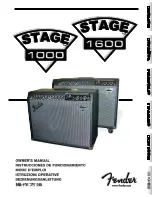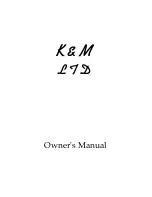
1. FRONT PANEL - MIC IN (1, 2)
CLASS-A high voltage preamp, no integrated circuits, no NFB
ROY
OL
IN
¿
GAIN
WARM
6
STEREO
IN
MASTER
LINE OUT
INSERT
DI OUT
7
VOLUME
IN
10V
LOW
MID
HIGH
REV (AUX)
VOLUME
5
MULTIEFFECT
L
R
Delay + Rev
Delay 100ms
Delay 200ms
Delay 300ms
Delay 400ms
Delay 500ms
Delay 800ms
Voice doubler
Chorus slow
Chorus medium
Chorus fast
Rev
Delay
(150ms)
Flanger slow
Flanger medium
Flanger fast
MIX
ENCODER
MULTIEFFECT
AUX OUT
REVER
master
DECAY
OL
OL
OL
OL
IN
IN
IN
IN
IN
GAIN
RESON
LOW
MID
HIGH
INSERT
REV (AUX)
VOLUME
4
MULTIEFFECT
48V
10V
150H
240H
GAIN
RESON
LOW
MID
HIGH
INSERT
REV (AUX)
VOLUME
3
MULTIEFFECT
48V
10V
150H
240H
FLAT
FLAT
48V
INSERT
GAIN
LOW
HIGH
GAIN
300H
3 3 H
700H
ARAMETRIC MIDS
REV (AUX)
VOLUME
2
MULTIEFFECT
48V
INSERT
GAIN
LOW
HIGH
GAIN
300H
3 3 H
700H
ARAMETRIC MIDS
REV (AUX)
VOLUME
1
MULTIEFFECT
1.1. MIC INPUT
This input is electronically balanced for XLR type connections. The new MIC/DYN channel is now conceived for any kind of signal
sources. You can plug in vocal microphones. The electronics will adapt to any situation. No special action is required
1.2. INSERT
This stereo jack plug enables the connection of an external device (compressor, equalizer, etc.) in series to all the outputs
1.3. 48V
The amplifier’s XLR input provides 48V phantom power for use with a condenser microphone. Most condenser (and dynamic)
microphones, along with some preamps, can be safely phantom powered. In certain cases however, phantom power can cause
damage to a device.
This tends to occur with unbalanced microphones, preamps or stompboxes that have been modified for balanced XLR use.
For any doubt, please contact us to check the compatibility of your audio device before using the amplifier
1.4. GAIN
This variable gain preamplifier adjusts the sensitivity level to ensure the best possible processing of the MIC signal through the
channel.
It is important that this input level should be set and optimised in the best way to achieve the cleanest sound possible
1.5. OVERLOAD
This LED (when lit) indicates that the level of the inputsignal is too high and it might introduce distortions
1.6. HIGH, MID, LOW
These controls are devoted to high, medium and low frequency regulation. Offering cut and boost of ±15dB, they allow a wide range
of tonal variations to be explored. Parametrics MID regulation, offers the possibility to cut or boost a frequency range between 300Hz
and 3,3kHz. When the controls are positioned centrally there is no cut or boost of the selected frequency band
1.7. MULTIEFFECT
This rotary control sets the level of the selected effect on the channels
1.8. REVERB (AUX)
This rotary control simultaneously sets the level of the digital reverb on the channels and the level of the signal sent to AUX OUT.
1.9. VOLUME
This rotatory control regulates the channel volume
3.5
1.1
1.3
1.2
1.4
1.5
1.6
1.7
1.8
1.9






























